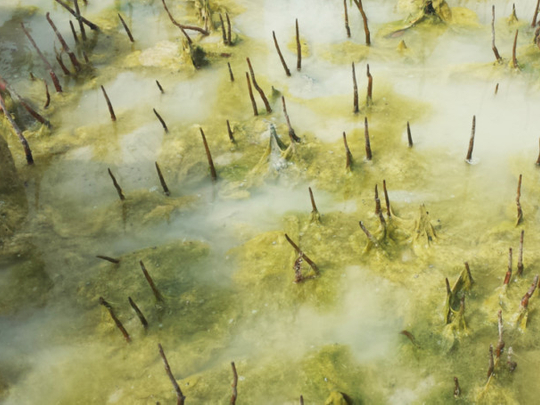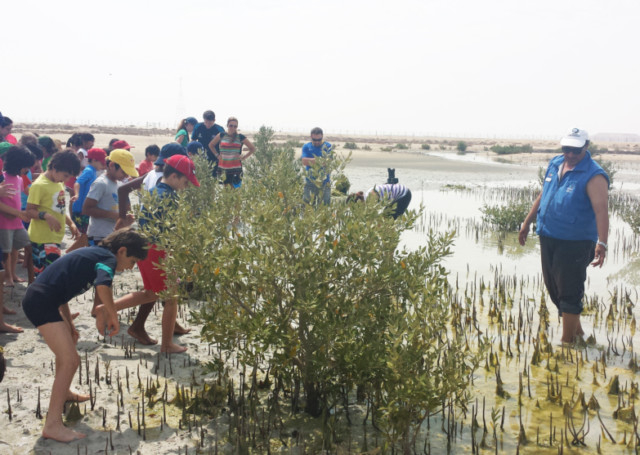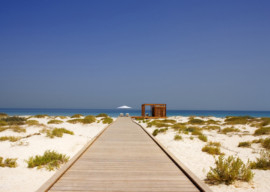
The UAE is home to remarkable coastal developments that have become symbolic of the country’s rise to prominence. Some of the iconic projects include elaborate island developments that are now popular destinations for residents and tourists in places that were completely inhabitable a few years ago. Dubai, in particular, has made a major breakthrough with the Palm Jumeirah, but now large-scale coastal developments in other emirates are also getting in on the action.
As these projects require massive amounts of resources, observers ask what’s the real cost of these developments? While these projects are making significant economic contributions, marine experts say they also have an impact on the environment. Not all negative, the use of innovative coastal engineering methods has also helped protect and even establish new marine habitats for the affected marine life.
Coastal urbanisation is not unique to the UAE. About 45 per cent of the world’s population live on the coastline and about two-thirds of the world’s largest cities are built along the coast, says Dr John Burt, a marine biologist and Associate Professor of Biology at New York University Abu Dhabi.
Common marine habitats
It’s the rapid pace and the scale of work that are drawing people’s attention to these coastal developments.
“There are only a few places in the world that have this sort of pace of development and that’s basically because of the large economic boom that we’ve had in the past several decades,” says Dr Burt. “Particularly, in the past ten years there’s been widespread coastal development in the UAE and the wider GCC.”
Dr Burt has spent several years studying marine ecosystems in the UAE and has worked closely with developers and environmental groups to protect the country’s marine life and fauna.
“There are still many high-value coral reefs out there on our coastline that are susceptible,” says the marine ecologist. “These are fragile ecosystems. They are under threat from ongoing and future coastal developments.”
Managing future coastal developments is critically important for the conservation of these sensitive ecosystems, adds Dr Burt.
The three main marine habitats found in the country are mangroves, seagrasses and coral reefs. Such ecosystems are of vital importance to the region’s economy and ecology, explains Dr Aaron Bartholomew, Associate Professor of Biology at the American University of Sharjah.
For example, coral reefs not only offer coastlines a natural protection from harsh waves and storms, but also serve as habitats for commercially important species of fish that are high in demand but critically low in supply, such as hamour.
Coral reefs cover less than 1 per cent of the earth’s surface, but they contain a quarter of all species in the sea. On a global scale, corals provide $29.8 billion (Dh109.45 billion) to the economy every year, according to one estimate, mostly by supporting fisheries, protecting coastlines from storms and erosion and encouraging tourism. Nearly 20 per cent of coral habitats have been lost globally due to various reasons, including climate change, destructive fishing practices, farming and coastal development.
“These habitats have economical benefits that benefit other people in the country,” says Dr Bartholomew. “When this habitat is destroyed, the fishermen are hurt, the people who are involved in dive and snorkel tourism are hurt, in addition to the important negative impact on the ecology.”
Man-made islands
Born on the beachfront of Dubai, Major Ali Saqar Sultan Al Seweidi’s heart has always been with the sea. And so he has made it his mission to safeguard marine and terrestrial ecosystems.
To work towards this goal, Al Seweidi, an avid pearl diver and fisherman, established the Emirates Marine Environmental Group (Emeg) in 1996.
“Our culture and heritage is deeply rooted in the sea,” he says. “Your culture is your foundation. Without it, you have nothing to hold you up. And this is why we must protect these ecosystems for the future generations.”
Among Al Seweidi’s projects was to preserve the coral reefs located where the Palm Jebel Ali and Dubai Waterfront are being constructed. These two developments were a major concern to experts because of their location. While reclamation work on Palm Jebel Ali are complete, work on Dubai Waterfront was indefinitely suspended in 2009 after partial reclamation.
“People should be aware of the difference between Palm Jebel Ali and Palm Jumeirah,” says Dr Bartholomew. “Palm Jumeirah was built on soft sediment, on a sandy, silky bottom. The Arabian Gulf has plenty of this kind of habitat, so building on that area is not a big loss. But Palm Jebel Ali was actually built on top of prime coral habitat and most of the naturally occurring coral is now gone.”
According to the book Marine Ecosystems in the UAE Emeg published in 2012, the low-lying nature of the southern coast, along with the characteristic muddy sabkha areas, make it an unsuitable location for most coral growth. However, it is estimated that the total coral reef surface area in the UAE is 1,190 sq km. After the Saudi Arabian reefs, the Jebel Ali reefs are believed to have the highest cover and diversity of corals in the Gulf with about 34 species.
Many of the reefs in the region were severely affected by mass coral bleaching, a global phenomenon that was associated with elevated sea surface temperatures resulting from El Niño events in the late 1990s.
Translocation
With the support of Nakheel, the developer of Palm Jebel Ali and the Dubai Waterfront, Emeg manually translocated about 12,000 living coral colonies before construction began. More than 90 per cent of the translocations were successful for a procedure that has a global success rate below 50 per cent.
In addition, an island that was located between Palm Jebel Ali and Dubai Waterfront in the original plan was moved to become part of the redesigned Waterfront because of its predicted impact on the coral reefs.
“The most important thing is to conduct a study first and from there you can build your plan,” says Al Seweidi. “That’s what we’ve done with Nakheel. We were there before they laid the very first stone.”
No small feat
A 3x5km plot now known as the Ghantoot Reserve was handed over by Nakheel to Emeg to protect the abundant marine and wildlife in the area and run it as an educational facility. The area was in the original footprint of Dubai Waterfront. It is now an important sea turtle nesting area. The plot is part of more than 60km of total protected zones on Nakheel development sites, from Deira Islands to Palm Jebel Ali and Dubai Waterfront.
“We are very happy that Nakheel was proactive and the result of this was something magical,” says Al Seweidi. “It’s truly a wonderful accomplishment that we were able to preserve all of this, given such a vast development. It’s not something to be taken lightly.”
Marine experts say location is the most important factor developers must consider when planning their projects.
“Before you even start construction, you want to site these things so that they’re built in a location that’s not going to impact more sensitive habitats,” says Dr Burt. “You will never build an offshore project with no impact. But it’s a matter of minimising and then mitigating those impacts, so site selection is probably the most important consideration.”
Developers are required by regulators to conduct environmental baseline studies and impact assessments, with corresponding plans to reduce and mitigate the expected impact of their projects. In the case of Nakheel, the regulator was Trakhees.
“The Environment, Health and Safety division [of Trakhees] has pre-qualified specialised consultants,” explains Brendan Jack, head of sustainability and environment at Nakheel. “The studies are then carried out independently by the consultants and we provide whatever information they request.”
Limited coastline
The consultants produce draft reports, which are then reviewed by the regulator and provided to Nakheel and the Dubai Municipality for comments and recommendations that are implemented as part of the environment management plan.
As a policy, Nakheel does not release its environment impact assessment because of the documents’ commercial sensitivity. However, Jack says about 30 findings came out of the impact study, including those related to marine and terrestrial life. Once those were mitigated, only two or three of those impacts were rated as either moderate or higher. These were mainly related to the location of the project, in which the developers were constrained.
“Dubai has a fairly limited coastline and most of it was taken up with a whole range of different things, whether it was ports, hotels, power supplies or desalination [tanks],” says Jack. “Most of the existing coastline of what was known as old Dubai was already gone, so we had very limited choice on where we should put the project.”
Moreover, Jack points out the developer is working according to a government plan.
“It is a plan that looks at the whole range of benefits to Dubai, associated with these projects,” he says. “They’re not just construction projects or development projects. They become tourism projects, they become the face of Dubai, they become integral to the whole economy of the emirate.”
Pre-emptive measures
Among the big problems associated with coastal development are dredging and filling, says Dr Bartholomew.
“As you’re taking sand and silt from one area and dumping it on another, a lot of the silt gets suspended in the water and the water becomes very cloudy, potentially for a long time,” he says. “The cloudiness, if it persists for several months, can kill seagrass beds and corals, which are photosynthetic and need sunlight. In the case of corals, the sediment can settle on top of them and they can get smothered.”
One effective method to prevent this is the use of silt curtains, which are placed around the affected area. The curtains act as a barrier to stop the material from drifting further.
In addition to using silt curtains, Nakheel says it monitors its contractors closely to limit the impact of dredging work on marine habitats. The developer also sets requirements for the quality of material used to reclaim the land, and installs screens on the hoses used to pull material from the seabed.
“We are very specific about the quality of the material. The very small particles, the fines, can’t make up more than 5 per cent of the volume of the sand,” Jack says. “The fines is what causes the spreading of the sediment. If you limit the material, that helps control the spread.
“So we’re not just studying where the material goes, but also where it comes from to make sure there are no significant habitats affected and the material meets engineering and environmental requirements.”
Studies have consistently shown the important role breakwaters play in the formation of marine communities in the long term. Breakwaters are large structures used to safeguard coastlines from the impact of waves, however, they also have an important secondary role.
Complex habitats
“Breakwaters to me are far more ecologically important than the purpose-built artificial reefs. Even though they are not intended to be artificial reefs, they take on that role,” says Dr Burt, who has done a series of studies comparing marine communities on breakwaters to those on natural reefs.
One of his findings is that breakwaters are effective homes for fish, which are primarily interested in the complexity of these habitats.
“You often get fish communities that have a higher number of fish and higher diversity on breakwaters than on natural coral reefs, because coral reefs here tend to be relatively flat compared to other areas,” says Dr Burt. “But when you build a breakwater with these stones, you’re putting in a lot of three-dimensional structures.
“There’s a lot of space and crevices where different reef fish can hide, so they can make an important difference for the types of fish communities you get.”
Another important point to consider in the design of breakwaters is the structure’s material. A study headed by Dr Burt in 2009 that looked at the effect of breakwater material on coral recruitment found that corals and larvae tend to prefer gabbro, a stone available in the mountains of the UAE, over granite, concrete and sandstone.
“This is probably because this rock is relatively basic. It’s not acidic, as corals don’t tend to associate with acidic material,” says Dr Burt.
Dr Bartholomew was part of the team that worked with Dr Burt in another study that compared colonisation on breakwaters that have been around for more than 25 years, particularly those at Dubai Dry Docks and Jebel Ali Port, to those on natural reefs.
“We found about 50 per cent coverage, meaning half of the entire surface was covered with living coral,” Dr Bartholomew says. “That’s actually a very high number if you look at the percentage of coverage of corals in natural areas around the world, which is usually below 50 per cent.”
Dr Bartholomew attributed the findings to the challenges often found in the natural environment.
“In natural habitats there’s sand all around and when sand is stirred up, it settles on top of the corals and can probably disturb them,” he says. “This is not as much a problem on the boulders as they are away from the sand.”
All these factors make it essential that during the design and construction phase, contractors should orient the breakwaters to maximise wave exposure and use amenable material, which will enhance colonisation by corals and reef fish.
Bad news
Although studies have shown the potential of breakwaters as primary habitats for marine life and fauna, there are limitations as experts emphasise breakwaters are not replacements for natural reefs.
The first challenge is that colonies on breakwaters take decades to mature, going well into 30 years.
“This process of recovery can be on the order of decades and will not fully replace what was on a natural reef,” says Dr Burt. “Yes, you’ll make a new reef, but different.”
Another challenge is the change in the community’s structures, as numerous studies show diversity was compromised when it came to coral reefs.
“The problem is that natural coral reefs are more diverse,” says Dr Bartholomew. “We found 29 species associated with natural habitats, but only 20 species of coral were on breakwaters. So some corals that exist naturally don’t thrive on breakwaters. In addition, different species predominate on the breakwaters than on the natural reefs.
“So it’s not all bad, but it’s not all good, either. Ultimately, I strongly feel more effort should have been made to preserve the natural corals.”
Mitigating the impact
Much effort has been placed by developers to mitigate the environmental impact of coastal development. In the case of Palm Jebel Ali, the favoured gabbro rock was used to from breakwaters and create a dynamic environment for marine life.
“By choosing different rock sizes, with bigger outer rocks and smaller secondary rocks, you create differently sized spaces between them,” explains Jack. “What that does from an ecology perspective is it creates different habitats for a whole range of different animals. That then builds a diversity and a depth to an ecosystem that you don’t get anywhere close to with concrete.”
In the breakwaters at Nakheel’s The World development, water passes through both sides of the structures and in some cases this has spawned marine life that did not exist prior to the development.
“That breakwater is 27km long, so it actually creates 54km of two different types of habitats,” says Jack. “You have an open-water habitat on the outside and a lagoon habitat on the inside, and this brings different creatures.”
In addition, breakwater slopes were placed at heights of between 5m and 15m below the water level, the optimum growth depth for the species of corals that colonise the breakwater.
“If it’s too shallow, the corals will die because they literally get sun burnt, and if it’s too deep, there’s not enough sun penetration,” says Jack. “So that’s the sort of thinking that goes into the design.”
Seagrass, which does not grow in the open ocean and typically thrives in protected areas, has grown in the shelter of Palm Jebel Ali and Dubai Waterfront. This has attracted vulnerable marine mammals such as the Dugong, which had not been seen from Dubai’s waters for generations.
“In the entire Gulf there are only three types of seagrass, and they can all be found here in Jebel Ali,” says Al Seweidi. “We have found the Dugong returning, we have there dolphins and more than 45 types of fish. This means marine life is recovering. It’s a truly beautiful process to be thankful for.
“But we must not stop. We must continue working together to conserve and preserve this vast ecosystem that protects us in return.”






